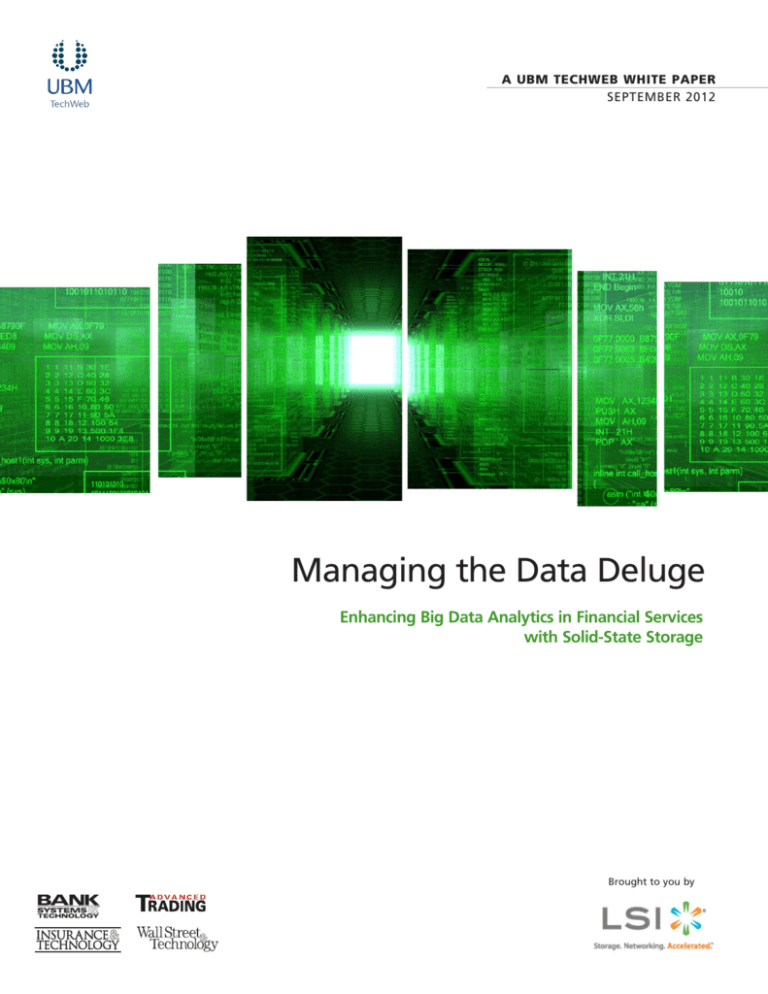
A UBM TECHWEB WHITE PAPER
SEPTEMBER 2012
Managing the Data Deluge
Enhancing Big Data Analytics in Financial Services
with Solid-State Storage
Brought to you by
Managing the Data Deluge
Enhancing Big Data Analytics in Financial Services with
Solid-State Storage
By Anne Rawland Gabriel
2
ABOUT THE AUTHOR
Anne Rawland Gabriel is a
technology writer and marketing communications consultant
based in the Minneapolis/St.
Paul metro area. Among other
projects, she’s a regular contributor to TechWeb’s Bank Systems
& Technology, Insur ance &
Technology and Wall Street &
Technology publications.
Across the industry, decision making is
becoming data-driven. In fact, according to a
recent survey by The Economist Intelligence Unit,
73 percent of C-level financial services leaders
reported that more and more management decisions are based on “hard analytical information.”1
Whether it’s meeting competitive, customer
or compliance demands, financial services firms
aren’t just striving to harness the proliferating
volumes of historical data. Many organizations
also want insights from new and unstructured
sources such as news reporting, Web usage trends
or social media chatter.
According to Gartner, “Business executives
and IT managers are increasingly referring to information as one of their organization’s most critical
and strategic corporate assets. Certainly there is a
sharp rise in enterprises leveraging information as
a performance fuel, competitive weaponry and a
relationship adhesive.”2
Such strong business needs have converged
with our recent ability to use a single large data
set to analyze information more effectively than
dividing that same amount of information into
smaller data sets. Use of a single large data set is
the essence of “big data.”
Not surprisingly, leveraging big data’s potential is rapidly becoming critical to the success of
financial services firms, whether an organization is
focused on investing, banking or insurance.
Indeed, The Economist Intelligence Unit study
showed that nine out of 10 surveyed business
leaders believe data is now the fourth factor of
production, as fundamental to business as land,
labor and capital.3
What the Buzz Is Really About
Precisely what constitutes big data may be a moving target, but a single data set can range from
dozens of terabytes to a data deluge encompassing multiple petabytes.
But the excitement in financial services isn’t
about collecting and storing large amounts of
data — a challenge the industry solved long ago.
Instead, the buzz is about speeding the response
times for data analysis and visualization and providing actionable information when it’s needed most.
To put it into perspective, let’s say your company monitors the trading activity of 10,000 global
stocks. When a new crisis breaks out in an oilproducing region, your business users want to
know what would happen — across the entire
10,000-stock landscape — if there were a 10
percent rise in the price of oil as a result of the
disruption. Further, they want to model the effects
of 20, 40 and 60 percent price increases.
For business users making billion-dollar decisions affecting their company and their clients,
1. “The Deciding Factor: Big Data & Decision Making,” The Economist Intelligence Unit as commissioned by Capgemini, June 2012.
2. Predicts 2012: Information Infrastructure and Big Data,” Gartner, November 29, 2011.
3. The Economist, “Deciding Factor.”
A UBM TECHWEB WHITE PAPER | Managing the Data Deluge
“We’re coming into a golden age of
parallel computing. Big data frameworks help bring parallel
computing out of the specialized domain of high-performance
computing and into the typical enterprise.”
—Jamon Bowen, LSI Corporation
3
getting immediate answers is imperative. And, they
want to do so by running the analyses themselves,
not by handing them off to a data expert in IT.
In other words, for financial services, the
issue isn’t the raw ability to manipulate large
amounts of data; robust business intelligence (BI)
tools have had that capability for some time. It’s
the emergence of technologies — both hardware
and software — that enable business users to
visualize actual trends and perform what-if modeling quickly and efficiently.
“Although the business intelligence tools
market exceeded $120 billion last year, our surveys show that only 30 percent of potential users
actually use them,” notes Rita Sallam, research
vice president at Gartner. The challenge, she says,
is “having self-service BI tools appropriate for
business users. A big reason for lack of adoption
is that the tools are just too hard to use.”4
Now, there’s a new breed of big-data applications, offering business users a dashboard-style
interface that converts complex analytical calculations and models into digestible, intuitive
and user-friendly charts and graphs. With a few
keystrokes, users can not only create multivariate
models but also view the effects of changing one
or more variables.
“If you’re trying to answer an ad hoc question,
not waiting a lengthy period for all the data to be
formatted in your enterprise BI solution is a fantastic advancement,” says Jamon Bowen, principal
technical marketing manager at LSI Corporation.
For instance, consider the previously discussed
crisis in the oil-producing region. With today’s big
data tools, global events of all kinds — a natural
disaster that shuts down a major tech manufacturing
hub or a farmers’ strike in a major food-producing
region in the Southern Hemisphere — can be analyzed in combination.
In addition to viewing how such events
change an entire data set, many big data tools
permit grouping inputs (such as company stocks)
to get a sector or regional view. And, these apps
allow users to drill down to see the impact on
individual inputs.
4. “Big Results from Big Data,” Wall Street & Technology magazine, May 2012
Local Storage Makes It Happen
To manipulate data quickly enough to deliver the
fast outputs required by financial services firms,
many big data software applications minimize
hardware-related delays by using local storage.
In a nutshell, today’s big data applications
typically leverage multicore main memory CPUs
in conjunction with direct-attached storage (DAS)
in a server. This is faster than pulling data over a
cable that extends to shared storage subsystems,
whether network-attached storage (NAS) or a
storage area network (SAN).
“Many of the big data structures are based on
bringing processing to data rather than data to processing,” affirms Bowen. “So the trend in big data
is scaling out using more locally attached storage.”
Indeed, many industry experts, like LSI’s
Bowen, predict that tremendous gains in performance will only accelerate. “We’re coming into a
golden age of parallel computing,” he says. “Big
data frameworks help bring parallel computing
out of the specialized domain of high-performance
computing and into the typical enterprise.”
“And,” he continues, “with 16-core processors, hyper-threading and 10 Gigabit Ethernet
networking, the numbers will just keep marching up.”
In a nutshell, this miniaturization and commoditization of grid computing makes it a
competitive imperative for financial services organizations to take advantage of today’s massively
parallel systems.
The Downside of Local Storage
for Big Data
As is true for many new technologies, there can
be a catch to using local storage for big data
applications: hard disk drive-related performance
bottlenecks.
In a typical big data architecture, each
server in big data is referred to as a “node.”
Multiple nodes are required and are arranged
in clusters. Within a node (server), there are
typically 12 to 24 high-performance enterprise
hard disk drives (HDDs). And, although HDD
performance metrics continue to climb, input/
output (I/O) bottlenecks are a continuous reality.
Such bottlenecks become a challenge in big
data because thousands of nodes (servers) are
commonly used. All of the nodes work on the
same data set simultaneously by performing functions and then providing the results to other nodes
or other clusters of nodes for further processing.
From a technical standpoint, the root of the
A UBM TECHWEB WHITE PAPER | Managing the Data Deluge
issue occurs during the “MapReduce” operation,
which consists of three different operations. The
“Map” and “Reduce” functions are designed to
stream data directly from disks. Between these
two operations, data is passed between the Map
and Reduce functions during a “shuffle” phase.
During this handoff, data passes between
Map and Reduce by first using disk storage, and
then transferring the data over the network. Given
the thousands of nodes involved, even the smallest
disk and network-related bottlenecks quickly add
up to degrade output.
While increasing the performance of both the
Map and Reduce operations has been the focus
of those who created big data computing, less
attention — thus far — has targeted performance
degradation during the handoff between the two
during the shuffle phase.
“The Map and Reduce functions have been
tuned for bringing processing to data,” explains
Bowen. “However, during the shuffle phase, the
effects of passing data from thousands of nodes, to
thousands of nodes, are frequently underestimated.”
“With so many nodes passing data, the I/O
bottlenecks can be substantial,” he adds.
4
Enter Flash-Based Application
Acceleration Technologies
Fortunately, financial services organizations can
now address the performance degradation that
occurs during the MapReduce shuffle phase with
flash-based application acceleration solutions such
as the LSI® Nytro™ product family.
LSI Nytro application acceleration
architecture can cut big data job runtimes by up to as
much as 40 percent.
Solutions such as the Nytro product family combine advanced software caching routines
with flash memory hardware mounted on a PCI
card. Since PCI cards easily slide into available
server slots, no additional power, cooling or space
demands are made.
Because flash storage offers dramatically
lower data access times than disks, it can provide
a superior platform for caching data. According
to the Storage Networking Industry Association,
the storage industry’s standards body, flash-based
storage access times range from 100 to 1,000
times faster than for a mechanical HDD.5
5
Not surprisingly, adding sophisticated caching algorithms, such as those found in the Nytro
application acceleration architecture, to a flash
hardware card can take performance to the
next level.
According to independent lab validation testing provider Demartek, “caching on flash … places
a copy of ‘hot’ data into its cache so that I/O
activity can be accelerated. This caching technique
benefits any application whose data is considered
‘hot’ and is within the scope of management and
visibility of the cache.”6
Frequently called “server-side caching,” the
technology accelerates I/O activity without requiring changes to the applications running in the host
server, says Demartek.7 Among other things, this
improves overall storage performance, including
DAS-based storage, and drives down latency.
While performance gains vary depending on
the situation, Bowen says using LSI Nytro application acceleration architecture can cut big data job
runtimes by up to as much as 40 percent.
Meeting Big Data Application
Acceleration Needs
Clearly, flash-based solutions, such as the LSI Nytro
Application Acceleration Architecture, can help
financial services users improve big data modeling capabilities to enable fast, compliant real-time
decision making.
Specifically, the Nytro product family of
intelligent solid-state storage includes two solutions appropriate for big data platforms in the
financial services:
• Nytro MegaRAID ® application acceleration
cards are appropriate for off-the-shelf big
data setups, where data placement during
MapReduce is typically not addressed. In these
circumstances, LSI Nytro MegaRAID intelligently
places data behind the scenes without requiring
any investment in big data application development. Additionally, the product provides data
protection within big data nodes with LSI RAIDon-Chip (ROC) technology, which supplies RAID
levels 0, 2, 5 and 6.
• Nytro WarpDrive™ application acceleration
cards are best for big data applications where
the framework decides how to place data.
Typically, this occurs in very large big data setups where application developers control data
placement. Generally, there are known locations
where a flash-based solution will improve performance most effectively.
“Solid State Storage 101: An Introduction to Solid State Storage,” Storage Networking Industry Association, September 2009.
6
LSI® Nytro™ XD Caching Solution Evaluation, Demartek, LLC, April 2012.
7
Ibid.
A UBM TECHWEB WHITE PAPER | Managing the Data Deluge
No matter which solution is best for your
organization, the LSI Nytro product family offers
the following key features to benefit all types of
big data environments:
• Automatic Data Placement detects data
“hot spots,” intelligently determines the best
location for that data and then places it onto
the appropriate disk — all in the background
and at lightning speed. This capability can
significantly boost performance during the
MapReduce operation.
• Flexible Solution permits deploying LSI Nytro
PCIe cards with a wide variety of hardware
and software, regardless of the customizations
an organization has made to applications or
operating systems. “For example, organizations frequently tweak the Linux® operating
system,” Bowen points out. “By providing the
driver source code with some Nytro solutions,
flash-based application acceleration can be
realized in these environments.”
• Cost-Effective to deploy within big data environments of any size. “It’s possible to use a very small
amount of flash in comparison to hard disk,” says
Bowen. “For example, 500GB of Nytro cards can
accelerate up to 10TB of hard disk.”
• Scalable to meet the needs of expanding big
data demands. Nytro PCI cards offer various
scalability options. A single Nytro MegaRAID
supports up to 128 hard disk drives within a
big data node. And, Nytro WarpDrive comes in
capacity options ranging from 200GB to 3.2TB.
In short, flash-based application acceleration can provide financial services organizations
with the missing piece in the big data puzzle. By
addressing inherent hard disk-related latencies
during the MapReduce operation, the LSI Nytro
product family is playing a significant role in
delivering the real-time analytics that organizations need to meet competitive, customer and
compliance demands. ■
5
ABOUT LSI
LSI Corporation (NYSE: LSI) designs semiconductors and software that accelerate storage and networking in data
centers, mobile networks and client computing. Our technology is the intelligence critical to enhanced application
performance and is applied in solutions created in collaboration with our partners. More information is available
at www.lsi.com.
LSI, the LSI & Design logo, MegaRAID, Nytro and WarpDrive are trademarks or registered trademarks of
LSI Corporation. All other brand or product names may be trademarks or registered trademarks of their
respective companies.
© 2012 UBM TechWeb, a division of UBM LLC. All Rights Reserved.








